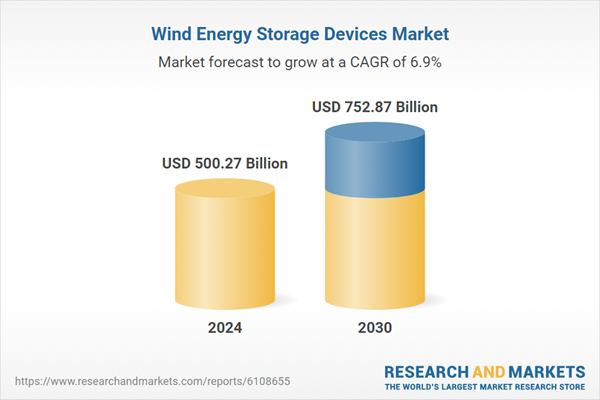Speak directly to the analyst to clarify any post sales queries you may have.
10% Free customizationThis report comes with 10% free customization, enabling you to add data that meets your specific business needs.
Key Market Drivers
Increasing Integration of Renewable Energy into Power Grids
The accelerating global transition to renewable energy is a major driver for the wind energy storage devices market. Wind power, while sustainable and abundant, presents challenges due to its intermittent nature. This unpredictability can affect grid reliability, necessitating the use of energy storage systems to store surplus electricity and discharge it when generation dips or demand spikes. Energy storage technologies enable better load balancing, frequency regulation, and seamless renewable integration, making them essential components of a modernized, flexible power grid. Governments and utilities are heavily investing in wind-energy-linked storage to ensure uninterrupted power supply and enhance grid resilience.Key Market Challenges
High Capital Investment and Uncertain Return on Investment
The integration of energy storage with wind power infrastructure involves significant upfront capital, often making projects financially challenging - particularly in developing regions. Beyond the costs of establishing wind farms, adding storage systems such as lithium-ion or flow batteries increases the financial burden due to installation, control systems, and long-term maintenance requirements. Additionally, returns on investment may be uncertain or delayed, depending on market tariffs, energy pricing volatility, and regulatory structures. This creates hesitation among investors and utilities, potentially slowing widespread adoption of large-scale hybrid wind-storage projects.Key Market Trends
Integration of Hybrid Wind-Storage Systems for Grid Stability
A growing trend in the wind energy storage devices market is the adoption of hybrid systems that combine wind farms with energy storage technologies. These integrated solutions are proving essential for grid stabilization, especially during peak demand or when wind output fluctuates. Battery energy storage systems (BESS) are increasingly being deployed alongside wind farms to provide real-time energy dispatch, grid frequency support, and time-shifting of renewable generation. The expansion of such hybrid solutions is being driven by advancements in smart grid controls, supportive policy frameworks, and the growing need for decentralized power systems.These systems are particularly beneficial in remote or island regions where grid infrastructure is limited. Governments and developers are scaling up projects from pilot phases to utility-scale deployments, supported by innovations in power conversion systems, AI-powered control algorithms, and modular battery platforms. Moreover, long-duration storage technologies such as compressed air and hydrogen systems are gaining interest as complementary solutions for wind power integration. As countries pursue renewable energy targets and grid modernization, hybrid wind-storage solutions are poised to become a cornerstone of global energy transition strategies.
Key Market Players
- Siemens Gamesa Renewable Energy, S.A.
- General Electric Company (GE Renewable Energy)
- Vestas Wind Systems A/S
- Tesla, Inc.
- Fluence Energy, Inc.
- ABB Ltd.
- NextEra Energy, Inc.
- LG Energy Solution, Ltd.
- BYD Company Limited
- Enercon GmbH
Report Scope:
In this report, the Global Wind Energy Storage Devices Market has been segmented into the following categories, in addition to the industry trends which have also been detailed below:Wind Energy Storage Devices Market, By Storage Technology:
- Battery Energy Storage Systems (BESS)
- Mechanical Storage
- Thermal Energy Storage
- Hydrogen Energy Storage
Wind Energy Storage Devices Market, By Application:
- Grid Integration
- Frequency Regulation
- Peak Shaving
- Renewable Energy Time-Shifting
- Emergency Backup Power
- Microgrids & Off-Grid Systems
Wind Energy Storage Devices Market, By Region:
- North America
- United States
- Canada
- Mexico
- Europe
- France
- United Kingdom
- Italy
- Germany
- Spain
- Asia-Pacific
- China
- India
- Japan
- Australia
- South Korea
- South America
- Brazil
- Argentina
- Colombia
- Middle East & Africa
- South Africa
- Saudi Arabia
- UAE
- Kuwait
- Turkey
Competitive Landscape
Company Profiles: Detailed analysis of the major companies present in the Global Wind Energy Storage Devices Market.Available Customizations:
With the given market data, the publisher offers customizations according to a company's specific needs. The following customization options are available for the report.Company Information
- Detailed analysis and profiling of additional Market players (up to five).
This product will be delivered within 1-3 business days.
Table of Contents
Companies Mentioned
- Siemens Gamesa Renewable Energy, S.A.
- General Electric Company (GE Renewable Energy)
- Vestas Wind Systems A/S
- Tesla, Inc.
- Fluence Energy, Inc.
- ABB Ltd.
- NextEra Energy, Inc.
- LG Energy Solution, Ltd.
- BYD Company Limited
- Enercon GmbH
Table Information
| Report Attribute | Details |
|---|---|
| No. of Pages | 180 |
| Published | July 2025 |
| Forecast Period | 2024 - 2030 |
| Estimated Market Value ( USD | $ 500.27 Billion |
| Forecasted Market Value ( USD | $ 752.87 Billion |
| Compound Annual Growth Rate | 6.8% |
| Regions Covered | Global |
| No. of Companies Mentioned | 10 |









